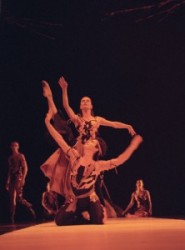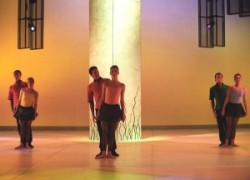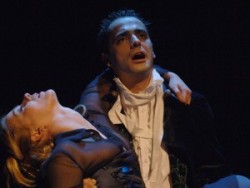GALLERIES
|
ART PHOTOGRAPHY
I consider my way of seeing things to have been originated at the end of the 1960s, beginning of the 1970s. In those years I wandered throughout the country with my friends, often also by myself and later as a musician. It was maybe the impressions gathered during those years that helped the formation of my visual world. I think I have always been a contemplative type. Living near the City Park (VÃĄrosliget) I watched passers-by and lonely people sitting on the benches at dawn or dusk. Of what I had not been aware at that time, my photos already revealed, namely, that deeper connections hide beyond the snapped moment, that things more often than not are not what they seem and the moment caught in the picture is but a code for the viewer.
|
|
|
|
|
|

|
BÃĐjart, Le Teck
|
BÃĐjart, Le Teck, Dancer. Catherine Zuasnabar, JulienFavreau.
The French-born Bejart set new standards during a career that spanned five decades, starting with his signature work, the 1959 staging of Stravinsky's "Rite of Spring," in which his dancers -- clad in sleek, shiny tights -- created an erotic aura with impulsive, natural movements that became a standard of âĶ
|
|

|
BÃĐjart, Juan and Theresa
|
BÃĐjart: Juan and Theresa
The French-born Bejart set new standards during a career that spanned five decades, starting with his signature work, the 1959 staging of Stravinsky's "Rite of Spring," in which his dancers -- clad in sleek, shiny tights -- created an erotic aura with impulsive, natural movements that became a standard of âĶ
|
|

|
BÃĐjart, Elton-Berg
|
BÃĐjart, Elton-Berg. Dancer: Karline Marion, Octavio Stanley ÃĐs StÃĐphane Bourhis, Allan Fallieri |
|

|
The Miraculous Mandarin
|
âThree apaches at their den force a young girl to stand by the window and attract passing men into the room, men who will later be brutally robbed by them. There are three seduction scenes. The first man to be lured up is a penniless old man. The second is none better. However, the third man is a rich Chinese. The catch is good, the girl tries to dilute him with her dance and the Mandarinâs zest for the girl is aroused, he falls passionately in love with the prostitute. The apaches grab and rob him, stab him with a sword, smother and strangle him, but without avail: the Mandarin in love remains fixated on the girl. To save the situation, by a womanly instinct, the prostitute agrees to fulfill the Mandarinâs desire: The Mandarin and the prostitute embrace passionately and with his longing fulfilled, he dies in an ecstasy of love.â |
|

|
Splinters
|
TamÃĄs Juranics: Splinters
Stage-design and costumes: Zsuzsa MolnÃĄr
Splinters, bits and pieces and fragments. Fragments of destinies, loves and lives that so often determine the whole, at times our whole life. A night, when the unreal plays a real role, thus enhances the chance for accidental occurrences. I do not wish to speculate on the big questions of life, nor to draw a lesson at the end of the show; my intention is to simply highlight the bits and pieces of human destinies, true and false loves, desires, every-day Mandarins, disappointments, broken hearts â splinters. TamÃĄs Juranics.
|
|
|
|
|
|
|

|
Romeo and Juliet
|
Romeo and Juliet. Ballet of GyÅr, Koreographer: Robert North, Music: Szergej Prokofjev, dancer: Szabina CserpÃĄk, BalÃĄzs PÃĄtkai. |
|
|
|

|
In memory Ilona TÃģth.
|
In memory Ilona TÃģth.
KoreogrÃĄfus, rendezÅ: Velekei LÃĄszlÃģ, Jelmez:GyÅri Gabriella, Zene: Thomas Newman, Anne Dudley, James
Newton Howard.
TÃĄncoljÃĄk: TÃģth Ilona: SÃģthy VirÃĄg( HarangozÃģ-dÃjas). GyurmÃĄnczi DiÃĄna, HorvÃĄth KrisztiÃĄn, Dobilov Alekszej, Smith Daniel Ascher, SebestyÃĐn BÃĄlint, KÃĄtay TÃģth AndrÃĄs. MÅąvÃĐszeti vezetÅ, igazgatÃģ:Kiss JÃĄnos(Kossuth-dÃjas, Liszt-, Hevesi- dÃjas balettmÅąvÃĐsz, Ãrdemes mÅąvÃĐsz. |
|
|
|

|
Antonio MÃĄrquez Compani
|
Antonio MÃĄrquez: Reencuentros, Movimiento Flamenco
The Antonio MÃĄrquez Dance Company
MÃĄrquez had learnt the basics of his dancing skills first at the school of the Spanish National Ballet, later with renowned Spanish masters. He rose to fame in his country with his leading roles in ballets, and his unique, soaring dancing style soon paved his way to an international career. His buoyant, passionate dance and his distinct choreographies make his performances unforgettable.
MÃĄrquezâs Dance Company made its debut on 7 November 1995, in Seville, at the Teatro de la Maestranza, staging the show âMovimiento Perpetuoâ. In 1997 they won the Award Nureyev; a year later they were granted the Italian âTaranto Award for Best Entertainmentâ and the Spanish âAward for the Most Valuable Professional of the Danceâ. As a consequence of their brilliant performance at the 50th Havana Festival, their name got inscribed in the Golden Book of the History of the Cuba Balletâ. From 1999 on, the Company has been touring the stages of the World, e.g. the Monte-Carlo Opera, Madrid, Athens, and Japan, Brazil and France and Hungary.
|
|
|
|

|
Lovers of Ancona
|
Katalin Vajda: Lovers of Ancona
VÃĄrkonyi Andrea , Szaksz Gabriella, TimkÃģ JÃĄnos, MihÃĄlyi Orsolya , BÃĄtyai Ãva, Bartha Alexandra
Nagy BalÃĄzs, Venczel KovÃĄcs ZoltÃĄn, RÃĄdler Judit, Janisch Ãva. GyÅri 2007 |
|
|
|

|
Nana
|
Nagy AndrÃĄs, Emile Zola: Nana |
|
|
|
|
|
|
|
|
|
|
|
|
|
|





























